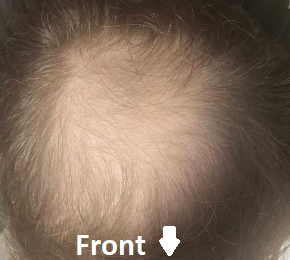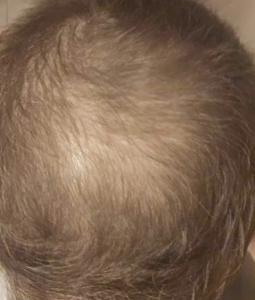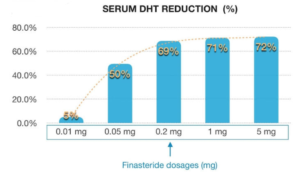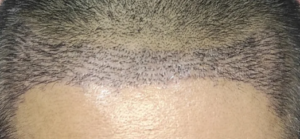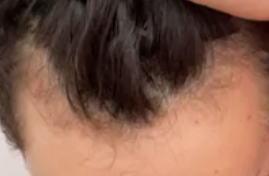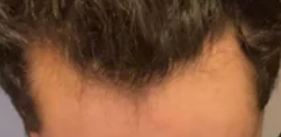My granddad, with the cleanest bald head ever, was prescribed Dutasteride 2 years back for some prostate issues and has grown a full head of hair since then, with follicles never seen before sprouting up. I’d never seen him with a single strand of hair my entire life. He got more hair than his 21-year-old grandkid now lol (and pretty dense too)
I have seen the same results from finasteride (Proscar 5mg dose) in elderly men (not extreme reversal as you reported, but a respectable regrowth of hair in a 75 y/o male). It gives us hope that the stem cells for advanced balding are still alive and can be stimulated. We are now seeing men in their 40s and even their 50s using microneedling and getting growth from an area with no hair for more than two 2 decades. The problem with microneedling is that we don’t have experience on how long the new hair induced by this process will last. I tell those who try and get results to set up a maintenance schedule, possibly by reducing the microneedling from once a week to once a month.
Finasteride delays atherosclerosis progression in mice and is associated with a reduction in plasma cholesterol in men –
I’ve developed a significant anxiety around accidentally pulling scalp hair out (I don’t mean hair that has reached the end of its cycle and is meant to come out, I mean active anagen hair. It can happen, for instance if hair gets caught in something like a zipper). To help put this phobia into perspective, do you have any insight on the likelihood that accidentally pulled hair grows back? If I were to reach up and pluck a healthy, anagen scalp hair, which percentage of the time will it grow back? I’m aware that repeated pulling out the same hair can cause permanent damage, I mean pulling that occurs only once.
If you pull out a healthy terminal hair once, it will come back. If you keep pulling out the same hair or hairs, they eventually will not come back.
I hear some people say that brand name worked better for them and then I also hear other people say that it doesn’t matter what brand you use…
It works because the FDA requires comparable testing for generic drugs. Some companies may not comply. If caught without compliance, they may never return to the market. FDA calls the consequences. I suspect that if you purchase a generic from a standard known pharmacy, it will likely be certifiable.
Topical finasteride goes through the skin into the body. There is a Topical liposomal finasteride preparation that largely stays in the skin. I often prescribe it to individuals who can’t tolerate regular finasteride. If you wish this, reach out to me and get a free consultation at williamrassman33@gmail.com
I’m tensed. So, please help me out . I had a HT 5 months back. I have been on finasteride 1 mg even before HT(for 8 months). Also, started minoxidil after 3 months of HT. I’m noticing hairball when it should have been stopped. My growth has been less. I still can see the gap in it. Is it a failed transplant? Also I have slight pimples like in transplanted area. Is it stilling the new growth ??
Give it another 2 months, and if you still don’t see the growth you expected, then a hair transplant failure is probable. If you went to a reputable doctor, then discuss the failure with that doctor. If you went to Turkey to a non-physician clinic, then that is what you bargained for, and you should see a reputable doctor to find out why there was a failure. Failures of a hair transplant result from (1) technical issues at the surgery, including faulty practices and lack of sound quality control systems in place. (2) autoimmune diseases that will wipe out a hair transplant, (3) DUPA, which always causes failure of a hair transplant.
There is a misconception that many patients and surgeons. They believe they must replace the density of the recipient area in the balding area when having (or doing) a hair transplant. Nothing could be further from the truth. Too many Reddit patients are wasting their donor supply by using too many grafts to cover Class 3 or 4 patterns of balding. Too many Reddit patients do not seek a Personalized Master Plan ((https://baldingblog.com/creating-a-personalized-master-plan-for-present-and-future-balding) with their surgeon before they embark on a hair transplant in Turkey or elsewhere. First, look at the analogy and the following numbers: Assuming a surgeon removed 12,500 grafts from the donor area in a Class 7 patterned patient. The average man has 50,000 follicular units (grafts) on his head (race in not dependent upon this number) of which 12,500 grafts reflect the donor area (12,500 grafts reflect 25% of the total follicular units). The total donor supply equals 25% of the total hair supply. This means that if the surgeons did only FUE and transplanted 12,500 grafts in the recipient area, there would be nothing left in the donor area. In such a surgery, the patient would likely become either bald in the donor area or heavily overharvested in the donor area if partial follicular units were excised rather than full FUe grafts. This patient would have a new problem: a bald donor area. His recipient area density would not exceed 30% of the original recipient donor density. With too many grafts removed from the donor area, there is no going back after this is done. Even transplanted numbers of 5000, 6000, or 7000 grafts reported by many Reddit patients reflect the maximum yield of their donor area if they have fine or possibly medium-weight hair. They may end up with a see-through donor area for their entire lives. Many of these Class 3, 4, or 5 balding patterns may leave very few grafts left in the donor area to address almost certain future balding because hair loss is ALWAYS progressive. When I review Reddit’s transplanted patient posts, I often see too many grafts for a particular balding pattern, reflecting poor planning and an impulse surgery decision in men who are often too young.
Transplanting into the recipient area is not blindly removing as many grafts as possible and moving them into the recipient area. An experienced, well-trained hair transplant surgeon, with proper knowledge of both the original donor density and hair mass of the patient’s donor area, can make proper artistic and mathematical calculations to obtain good results with less than the original recipient area density achieved. I have done this thousands of times on very bald men, even those in patients with a Class 6 or 7 pattern of balding, and I have never removed a total of 12,500 grafts. I have had thousands of satisfied patients over my 33-year career. I suggest that many of you review Dr. Linkov’s interview with me, which covers much of the history of botched hair transplants, even on celebrities such as Frank Sinatra. Here is the podcast link: https://baldingblog.com/dr-gary-linkov-blog-features-william-rassman/
When I transplant a Class 4A pattern balding patient, I often try to get frontal densities in the 35-40% range for the first 1 inch of hairline; then, I reduce the density I create. If the man has a particular hairstyle they like (for example, combing their hair left to right with a part on the left side), I would place a disproportional number of grafts on the parted side to enhance his styling and achieve a fuller look and save donor hairs on the opposite side. For the very bald man, such discussions with their surgeon are critical, as their donor supply may only be able to supply the needed hair to achieve a full-looking head of hair if proper planning is done in advance.
Yesterday, I met with a patient I had transplanted twice over 1 year, the last surgery just 8 months ago. He had a Class 6 balding pattern and a very poor donor supply, needing more hair to get to a full-looking head of hair than he had. To substitute for his lack of donor hair, I used beard hair for the top and mixed the beard hair with the hair I got out of his donor supply. The result was amazing. Such meetings make my day.
FYI: STATEMENT: 50% of recipient area density in a man with black hair and white skin is as good as 100% recipient area density. That observation is even more favorable as the skin becomes darker and the hair becomes lighter or the hair and skin color match. HOW THIS WAS DETERMINED: This was demonstrated by Dr. Manny Marrit some years ago when he plucked out 50% of the hairs on one side of the head of a man with medium-weight hair, which was black, and his skin was white. No one could tell the plucked side from the Non-pucked side.)
I don’t know the details of your donor supply; however, it is common to transplant the frontal half of the head so that the man in the mirror has hair. I would want to assess your central hair mass and see if it is going with a considerable number of miniaturized hairs. This central area often falls out if it is weak, but transplanting a good hairline and reinforcing this central area work in many men with a poor donor supply; however, the details of your donor density and donor’s hair mass would tell me a great deal. I have done such transplants on hundreds of men.
There are many reasons to have a great hairline including photoshopping it, use of concealers, or just a very good hair transplant in a person with coarse hair. I often show this repair job I did with dense packing of the hairline grafts, to show what a normal hair transplant should look like: https://baldingblog.com/wp-admin/post.php?post=9864&action=edit
I reposted this podcast for those of you who have not seen it. It has been widely received on Dr. Gary Linkov’s Podcast site.
Thank you for BaldingBlog and for answering all questions about hair loss! I have a bit of a less common question although I’m sure it comes up in your practice from time to time. I understand that if a balding man were to stop Finasteride then hair loss would resume and the balding pattern would advance to the stage it would have got to without Finasteride within 3 months. I also assume that if a transgender woman’s testosterone production is stopped chemically or surgically then there will be very little testosterone for the Finasteride to act upon. Would you advise continuing Finasteride for a time even after testicular testosterone production is stopped chemically and oestrogen is taken or is it fairly risk free to simply stop the Finasteride? Is there any real risk of hair loss because the Finasteride is stopped in your experience?Thank you in advance for answering this slightly less common question which will hopefully help many trans women in this situation.
You should be safe stopping finasteride; however, when hair loss occurs after finasteride cessation, there still could be a negative impact on your hair because of the intrinsic testosterone your body produces. If you don’t have problems with the drug, maybe it would be better just staying on it. Check with your doctor about this point.
The photo shows good density placement of the grafts; however, I noticed the grafts were placed in lines, like soldiers standing in formation. This will not be a problem for the patient unless his hair is straight. Straight hair at specific lengths will show this alignment of the hairs. This is a common finding as many surgeons have a sense of order, while Nature understood that hair groups were irregularly placed. In my practice, I’m a copycat, just copying what Nature would have done had it had been a hair transplant surgeon.
I’ve notice that men with Down syndrome are always going bald at an early age. Does anyone know why this would be? The only hormonal effect of Down Syndrome that I’m aware of is low thyroid. This may be a possible avenue for research. Maybe baldness is, in part, a thyroid issue.
About 50% of men will experience balding in their lifetime. That includes men with Down’s Syndrome.

